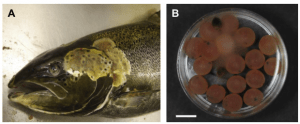Saprolegnia parasitica infection on: (A) Salmon and (B) Salmon Eggs. Image from a review form Pieter Van West.*
Saprolegnia parasitica is an important oomycete agricultural pathogen that causes mass mortality in trout/salmon and catfish populations. This pathogen causes a cotton-like growth on the skin and gills of stressed or vulnerable individuals. Since the mid-1930’s the dye malachite green (MG) was used as a fungicide in aquaculture. It was used mainly in fish hatcheries to protect young fish. However, due to suspected mutagenic properties MG and metabolites, its use as a fungicide in aquaculture is banned worldwide in the 1990’s. Efficient methods to limit Saprolegnia parasitica infections are still needed. It is estimated that a loss of up to 10% of farmed salmon succumbs to saprolegniasis (the disease caused by S. parasitica infection). Inorganic salts, formaldehyde, and peroxide treatments are currently used to fight this disease. The Peterson Group is interested in understanding this organism’s metal cell biology and the role of copper metalloenzymes in virulence. For this project, we are working with the Xiphophorus genetic stock center to characterize the metal response pathway of S. parasitica and the mechanism the pathogen utilizes for host infection and colonization.
Our research efforts in this area have been recently funded through the USDA!!!!
Current and past students working on this project:
Daniel Ledezma – Major Biochemistry ’22
Ramon Pena – Major Chemistry ’25
• Reference for image used above: A. H. van den Berg, D. McLaggan, J. Diéguez-Uribeondo, and P. van West, “The impact of the water moulds Saprolegnia diclina and Saprolegnia parasitica on natural ecosystems and the aquaculture industry,” Fungal Biol. Rev., vol. 27, no. 2, pp. 33–42, 2013.
